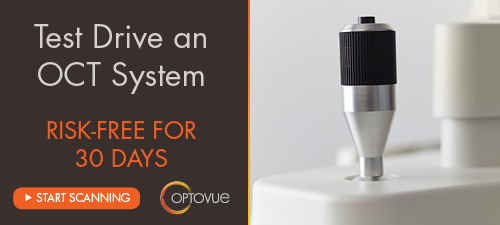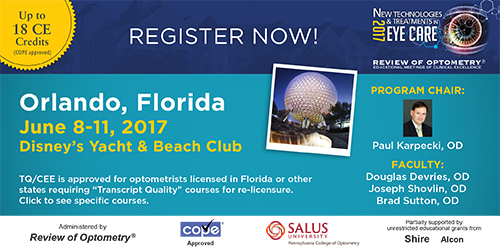
A
weekly e-journal by Art Epstein, OD, FAAO
Off the Cuff: Ch-Ch-Changes
As David Bowie sang: While you would think that this clearly would be practicing optometry without a license and that optometry boards in NY and CA would be up in arms, so far these opticians have been able to skirt existing laws by using ophthalmologists with time on their hands to sign off on prescriptions for patients they’ve never actually seen. While this might be gratifying to the few remaining antediluvian MDs who hate optometry, technology is, indeed, a harsh mistress, and the technology shoe will soon be on the other foot. Automated and autonomous cataract surgery isn’t that far down the stream, and what goes around, indeed, comes around.
|
|||||
 |
||
| Corneo-scleral Limbal Changes Following Short-term Soft Contact Lens Wear | ||||
Twenty-two neophyte subjects wore soft contact lenses for a period of five hours to assess whether short-term soft contact lens wear alters the anterior eye surface. Topography-based corneo-scleral limbal radius estimates were derived from height measurements acquired with a corneo-scleral profilometer. Additionally, central corneal thickness (CCT), anterior chamber depth (ACD), corneal curvature radius (R) and white-to-white (WTW) diameter were acquired with an OCT-assisted biometer. Measurements were obtained without lens wear (baseline) immediately after lens removal following five hours of wear, and three hours after lens removal. Short-term soft contact lens wear significantly modifies corneo-scleral limbal radius (mean ±SD: 130 ±74μm), and the changes are repeatable. In contrast, the WTW diameter and R were not modified. ACD and CCT were significantly affected, but no significant correlations were found between the increment of the limbal radius and the decrease in ACD and CCT. Limbal radius increment was reversed three hours after lens removal for 68% of the subjects, but the time course of this reversal was not uniform. It is possible to accurately quantify limbal radius changes as a consequence of soft contact lens wear. The increment in the limbal diameter could reach over 0.5mm but that alteration does not correspond to changes in WTW diameter, and it was not observable to the examiner using a slit lamp. Assessing topographical limbus after contact lens wear could be a tool to optimize the selection of the contact lens, from the perspective of anterior eye surface changes. |
||||
SOURCE: Consejo A, Bartuzel MM, Iskander DR. Corneo-scleral limbal changes following short-term soft contact lens wear. Cont Lens Anterior Eye. 2017; May 24. [Epub ahead of print]. |
||||
 |
||
| Assessment of Optic Nerve Head Pallor in Primary Open-angle Glaucoma Patients and Healthy Subjects | ||||
This study investigated optic nerve head (ONH) pallor quantitatively in patients with primary open-angle glaucoma (POAG) and in healthy subjects, and examined the relationship to mean deviation in perimetry (MD), cup-disk ratio (CDR) and diameters of retinal vessels. A total of 89 POAG patients (67.6 years ± 11.1 years) and 48 healthy subjects (63.3 years ± 14 years) were included. A dual-bandpass transmission filter was introduced in the illumination path of the fundus camera of the Dynamic Vessel Analyzer (Imedos Systems UG) and two monochromatic images at different wavelenghts (548nm ± 10nm and 610nm ± 10nm) were recorded simultaneously. ONH pallor was defined as the quotient of light reflection in both spectral channels. Pallor values were averaged over four fields that were positioned on the ONH. The mean of these measurements was calculated. In 47 of 89 POAG patients, diameters of retinal vessels were determined peripapillary. In POAG, the ONH showed a significantly higher pallor value compared with healthy subjects (82.34 ± 19.28 vs. 62.67 ± 10.41). ONH pallor was correlated with indicators used to estimate disease severity: MD and CDR. The pallor value was associated to diameters of retinal arterioles and venules. Pallor determined by this method was higher in POAG patients than in healthy subjects and increased in patients with advanced disease. ONH pallor might result from a reduced blood perfusion of the ONH or tissue atrophy accompanied by vessel obliteration in POAG. By measuring ONH pallor, additional diagnostic information about the vitality of the neuroretinal rim might be gained in glaucoma patients. |
||||
SOURCE: Ramm L, Schwab B, Stodtmeister R, et al. Assessment of optic nerve head pallor in primary open-angle glaucoma patients and healthy subjects. Curr Eye Res. 2017; May 30. [Epub ahead of print]. |
||||
|
|||
| Risk of Progression in Macula-on Rhegmatogenous Retinal Detachment | ||||
Patients referred for surgery due to primary rhegmatogenous retinal detachment with the macula on between 2009 and 2013 were included to identify factors that may lead to a rapid progression in macula-on rhegmatogenous retinal detachment (RRD); in particular, those that may lead to macular involvement. Relevant factors analyzed included age, time delay until surgery, lens status, myopia, the detachment's location and configuration, as well as number, size and type of retinal breaks. Eyes underwent optical coherence tomography to detect macular detachment. A multivariate analysis was performed to investigate the effect of several factors in the progression of retinal detachment. A total of 116 eyes of 116 patients were included. Mean time delay between admission and surgery was 1.8 days ± 1.4 days. Progression was observed in 19.8% of the eyes. Of those, 47.8% presented macular detachment. Ten of the 11 (90.9%) eyes presenting progression involving the macula also exhibited a bullous configuration, which was the only parameter that correlated significantly with detachment progression in patients with (p=0.0036) and without (p=0.0014) macular involvement. Researchers wrote that for the first time in a prospective trial, a bullous configuration was found to be a highly significant predictor for progression in macula-on detachments. The data supported prompt surgery in patients diagnosed with bullous macula-on RRD. |
||||
SOURCE: Callizo J, Pfeiffer S, Lahme E, et al. Risk of progression in macula-on rhegmatogenous retinal detachment. Graefes Arch Clin Exp Ophthalmol. 2017; May 27. [Epub ahead of print]. |
||||
 |
||
| News & Notes | |||||||||
| Bausch + Lomb Introduces renu Multipurpose Solution Bausch + Lomb renu advanced formula multipurpose solution for soft and silicone hydrogel contact lenses combines three disinfectants and two surfactants for effective cleaning and disinfection, and all-day comfort. The new offering will be the only renu solution on the market, replacing renu sensitive and renu fresh, beginning in June 2017 at major retailers. Read more.
|
|||||||||
| Alcon Unveils New Packaging for Dailies AquaComfort Alcon launched new packaging for Dailies AquaComfort Plus spherical contact lenses in 90-, 30- and five-packs to assist individuals with proper lens wear and care. The design features patient-friendly educational elements, including: detailed insertion and removal illustrations; a toll-free patient helpline and email address; and the Dailies website address for more at-home and online support. Additionally, the U.S. flag will appear on the new packaging to identify the boxes. U.S.-specific lot numbers will also enhance supply chain tracking capabilities. By the end of 2017, Alcon also plans to launch the packaging for Air Optix plus HydraGlyde contact lenses.
|
|||||||||
| Essilor Celebrates Anniversary of Mr. Orange With Special Offer Essilor Instruments is offering a six-year warranty for every order placed between June 1 and July 31 to celebrate the sixth anniversary of the Mr. Orange edger. In 2011, Mr. Orange won the SILMO d’Or award and was endorsed in 2014 with the Pont d’Or award from Inform’ Optique magazine, where roughly 11,000 opticians rank their favorite suppliers. Eye care professionals are encouraged to contact their Essilor Instruments sales representatives for details on the warranty coverage. Read more. |
|||||||||
| Avedro Corneal Collagen Cross-linking Phase III Keratoconus Study Results Published Avedro announced the publication of one-year safety and efficacy data from the randomized, controlled Phase III clinical trials that supported the FDA approval of Avedro’s Photrexa Viscous (riboflavin 5’-phosphate in 20% dextran ophthalmic solution), Photrexa (riboflavin 5’-phosphate dextran ophthalmic solution) and KXL System for the treatment of progressive keratoconus. Results from the clinical trials, in which 205 individuals with progressive keratoconus were treated at multiple U.S. sites, were published in Ophthalmology. |
|||||||||
| TearClear Completes $4.5M Series A Financing, Introduces Leadership Team TearClear announced the completion of its Series A financing, with proceeds totaling $4.5 million. The round was co-led by Visionary Venture Fund and Bluestem Capital. The company’s chemical filter removes benzalkonium chloride at the point of instillation, enabling multidose product preservation until the moment of application. In addition, the company assembled a team of ophthalmology veterans to drive the development of its filter technology. Read more. |
|||||||||
|
|||||||||
|
Optometric Physician™ (OP) newsletter is owned and published by Dr. Arthur Epstein. It is distributed by the Review Group, a Division of Jobson Medical Information LLC (JMI), 11 Campus Boulevard, Newtown Square, PA 19073. HOW TO ADVERTISE |





